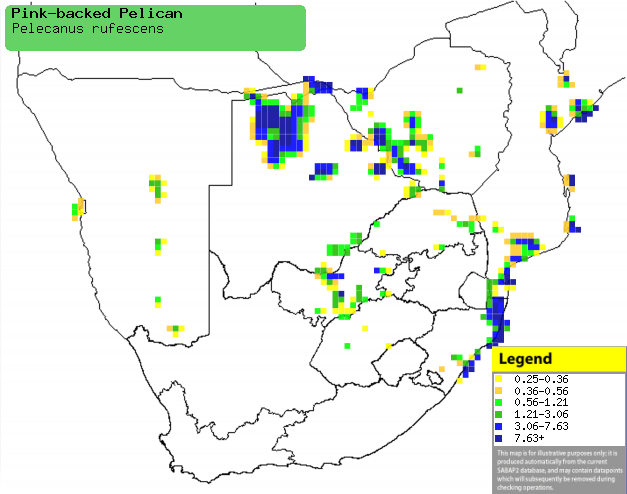|
Pelecanus rufescens (Pink-backed
pelican)
Kleinpelikaan [Afrikaans]; iFuba, iVuba (generic terms
for pelican) [Zulu]; Gumbula, Khungulu, Manawavembe, Xilandzaminonga (generic
terms for pelican) [Tsonga]; Kleine pelikaan, Roodrugpelikaan [Dutch]; Pélican
gris [French]; Rötelpelikan [German]; Pelicano-cinzento [Portuguese]
Life
> Eukaryotes >
Opisthokonta
> Metazoa (animals) >
Bilateria >
Deuterostomia > Chordata >
Craniata > Vertebrata (vertebrates) > Gnathostomata (jawed
vertebrates) > Teleostomi (teleost fish) > Osteichthyes (bony fish) > Class:
Sarcopterygii (lobe-finned
fish) > Stegocephalia (terrestrial
vertebrates) > Tetrapoda
(four-legged vertebrates) > Reptiliomorpha > Amniota >
Reptilia (reptiles) >
Romeriida > Diapsida > Archosauromorpha > Archosauria >
Dinosauria
(dinosaurs) > Saurischia > Theropoda (bipedal predatory dinosaurs) >
Coelurosauria > Maniraptora > Aves
(birds) > Order: Ciconiiformes
>
Family: Pelecanidae
Distribution and habitat
Occurs from south-west Arabia to much of sub-Saharan
Africa. In southern Africa, it is locally
fairly common in central and southern Mozambique, south-western Zimbabwe,
northern Botswana, the Caprivi Strip and north-eastern South Africa. It can occupy a variety of wetland types, generally
preferring dams, lakes, slow-moving rivers, lagoons, saline pools, estuaries,
lagoons and sheltered bays.
|
 |
|
Distribution of Pink-backed-pelican in southern Africa,
based on statistical smoothing of the records from first SA Bird Atlas
Project (©
Animal Demography unit, University of
Cape Town; smoothing by Birgit Erni and Francesca Little). Colours range
from dark blue (most common) through to yellow (least common).
See here for the latest distribution
from the SABAP2. |
Predators and parasites
It has been recorded as prey of Crocodylus
niloticus (Nile crocodile).
Movements and migrations
Resident and locally nomadic, moving in
response to changes in wetland conditions, although juveniles tend
to wander considerably longer distances than adults.
Food
It mainly eats fish, such as tilapia (Tilapia and
Haplochromis), occasionally supplemented with fruit, doing most of its
foraging alone in the period from in the morning and evening. It generally stays
close to the shore in shallow water, catching prey underwater with its large
bill pouch, draining the water out before throwing its head back and swallowing the
prey whole.
Breeding
- Little known in southern Africa, but well-studied in East Africa; it is
monogamous, breeding in colonies of roughly 15-140 pairs, often along with
storks,
herons,
African spoonbills and
African darters. Groups of
males display and attack each other, each selecting a nest site where he
performs to passing females.
- The nest is built by the female in about a week, with material gathered
by the male, consisting of an untidy stick platform with a shallow central
depression. It is typically placed in the canopy of a tree (often over water) or
occasionally on an island or reedbed.
- Egg-laying season is from June-January.
- It lays 1-4 eggs at 2-3 days intervals, which are incubated by both
sexes for 30-35 days (recorded in East Africa).
- The chicks are fed by both parents and brooded for the first few weeks
of their lives; younger chicks often die of starvation due to intense
competition for food with their older siblings. The oldest chick sometimes pecks the eyes
of the other chicks, causing them to fall off the nest. They take their first
flight at roughly 12 weeks old, leaving the nest completely a few days
later.
Threats
Not threatened globally, but Vulnerable in South
Africa, largely caused by wetland loss and degradation.
References
-
Hockey PAR, Dean WRJ and Ryan PG 2005. Roberts
- Birds of southern Africa, VIIth ed. The Trustees of the John Voelcker
Bird Book Fund, Cape Town.
|
